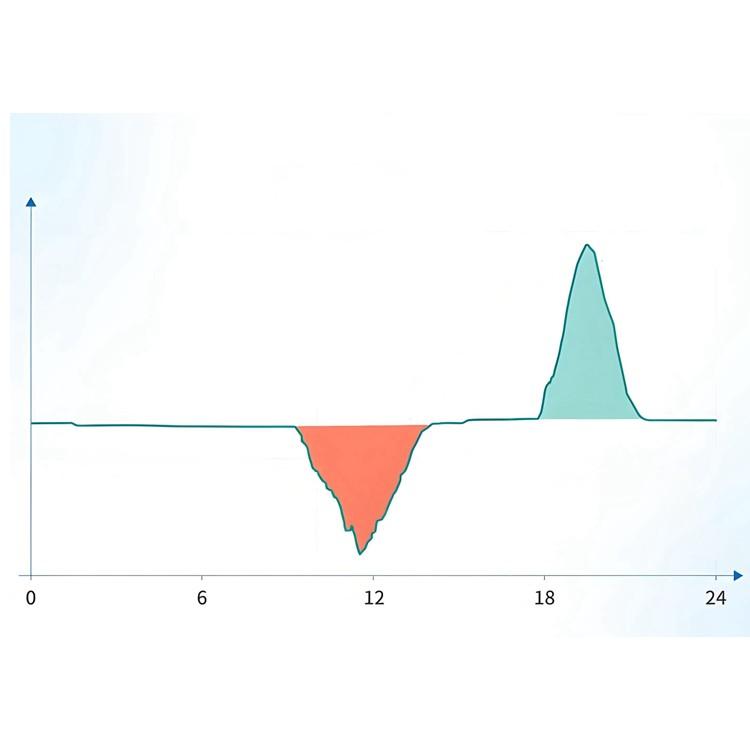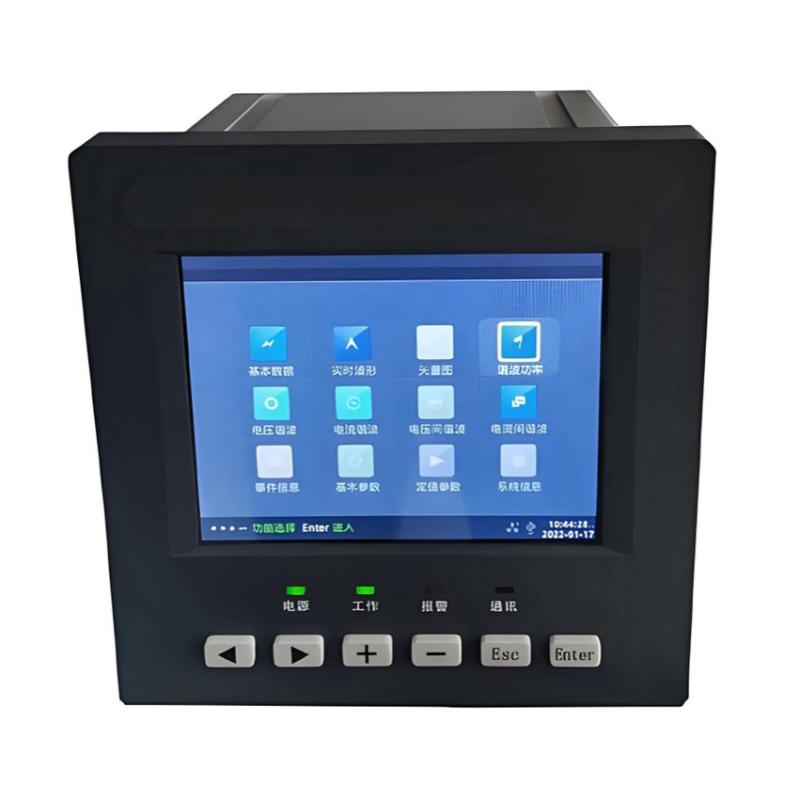Kapag ang Aktwal na Grid THD ay lumampas sa Limitasyon (hal. Voltage THDv > 5%, Current THDi > 10%), Dala ito ng Organikong Pagsisira sa mga Equipment sa Buong Power Chain — Transmission → Distribution → Generation → Control → Consumption. Ang mga Core Mechanisms ay Additional Losses, Resonant Overcurrent, Torque Fluctuations, at Sampling Distortion. Ang Mga Damage Mechanisms at Manifestations ay Malaking Variance Batay sa Uri ng Equipment, Tama ang Detalye Sa Ibabaw:
1. Transmission Equipment: Sobrang Init, Pagluma, at Drastically Reduced Lifespan
Ang Transmission equipment ay direktang nagdadala ng grid current/voltage. Nagpapahaba ang harmonics ng energy losses at insulation degradation. Ang Key affected components ay transmission lines (cables/overhead) at current transformers (CTs).
1.1 Transmission Lines (Cables / Overhead Lines)
Damage Mechanism: Ang Mas mataas na harmonic frequencies ay pinaigsi ang "skin effect" (ang high-frequency currents ay nakoncentrate sa surface ng conductor, binabawasan ang effective cross-sectional area), tumataas ang line resistance. Ang Additional copper losses ay tumaas sa square ng harmonic order (hal. 5th harmonic copper loss ay 25× kaysa fundamental).
Specific Damages:
Sobrang Init: Sa THDi = 10%, ang copper losses ay tumaas ng 20%-30% kumpara sa rated conditions. Ang temperatura ng cable ay maaaring tumaas mula 70°C hanggang 90°C (lumalampas sa insulation tolerance), nagpapabilis ng pagluma at pagcrack ng insulation layers (hal. XLPE).
Maikling Lifespan: Ang Prolonged sobrang init ay binawasan ang buhay ng cable mula 30 taon hanggang 15–20 taon, maaaring magresulta ng "insulation breakdown" at short-circuit faults. (Isang industrial park ay nasunog ang dalawang 10kV cables sa loob ng isang taon dahil sa excessive 3rd harmonic, nagresulta ng halos 800,000 RMB sa repair costs.)
1.2 Current Transformers (CTs)
Damage Mechanism: Ang Harmonic currents (lalo na 3rd at 5th) ay nagdudulot ng "transient saturation" sa CT iron cores, tumaas ang hysteresis at eddy current losses (additional iron losses). Ang Saturation ay distorting ang secondary-side output waveform, pinipigilan ang accurate representation ng primary current.
Specific Damages:
Core Overheating: Maaaring lumampas ang temperatura ng CT core sa 120°C, sinisingaw ang insulation sa secondary windings at nagreresulta ng ratio inaccuracies.
Protection Misoperation: Ang Distorted secondary current ay nagpapahiwatig sa protective relays (hal. overcurrent protection) na may "line short circuits," nagtrigger ng false tripping. (Isang distribution network ay naranasan ang 10 feeder trips dahil sa CT saturation, naapektuhan ang 20,000 households.)
2. Distribution Equipment: Madalas na Pagsisira, System Stability Collapse
Ang Distribution equipment ay mahalaga para sa "connecting upstream and downstream" sa grid. Ang THD na lumampas sa limit ay nagdudulot ng pinakadirekta na damage. Ang Key affected devices ay power transformers, capacitor banks, at reactors.
2.1 Power Transformers (Distribution / Main Transformers)
Damage Mechanism: Ang Harmonic voltages ay tumaas ang magnetic hysteresis at eddy current losses sa transformer cores (additional iron losses); ang harmonic currents ay tumaas ang winding copper losses. Samantalang, ang combined, these significantly raise total losses. Unbalanced three-phase harmonics also increase neutral current (up to 1.5× phase current), worsening localized overheating.
Specific Damages:
Core Overheating: Sa THDv = 8%, ang transformer iron losses ay tumaas ng 15%-20%. Ang temperatura ng core ay tumaas mula 100°C hanggang 120°C, nagpapabilis ng pagluma ng insulating oil (hal. 25# transformer oil), tumaas ang acidity, at bumaba ang dielectric strength.
Winding Burnout: Ang Long-term sobrang init ay carbonizes ang winding insulation paper (hal. Nomex), nagreresulta ng short circuits. Isang substation's 110kV main transformer ay naranasan ang winding short after 3 years dahil sa excessive 5th harmonic, ang repair costs ay lumampas sa 5 million RMB.
Reduced Lifespan: Ang Prolonged THD ay binawasan ang transformer lifespan mula 20 taon hanggang 10–12 taon.
2.2 Shunt Capacitor Banks (for Reactive Power Compensation)
Damage Mechanism: Ang Capacitive reactance ay bumababa sa frequency (Xc = 1/(2πfC)), kaya ang high-frequency harmonics ay nagdudulot ng overcurrent. Kung ang capacitors ay nabuo ng "harmonic resonance" sa grid inductance (hal. 5th-order resonance), ang current ay maaaring tumaas hanggang 3–5× rated value—maraming lampas sa capacitor ratings.
Specific Damages:
Insulation Breakdown: Ang Overcurrent ay sumisingaw sa internal dielectrics (hal. polypropylene film), nagreresulta ng puncture, bulging, o kahit explosion. (Isang industrial workshop ay nasira ang tatlong 10kV capacitor banks sa loob ng isang buwan dahil sa 7th harmonic resonance; ang replacement cost per bank ay lumampas sa 150,000 RMB.)
Protection Failure: Ang Resonant currents ay sumisingaw sa fuse links; kung ang protection ay hindi gumana, tumaas ang panganib ng sunog.
2.3 Series Reactors (for Harmonic Suppression)
Damage Mechanism: Bagama't ginagamit upang pigilan ang specific harmonics (hal. 3rd, 5th), ang reactors ay nagdudulot ng tumaas na winding copper losses sa ilalim ng long-term harmonic current. Ang Pulsating magnetic fields mula sa harmonics ay din nagpapalakas ng core vibration, nagdudulot ng mechanical wear.
Specific Damages:
Winding Overheating: Sa THDi = 12%, ang reactor copper losses ay tumaas ng higit sa 30%; ang temperatura ng winding ay lumampas sa 110°C, sumisingaw at nasisira ang insulation varnish.
Core Noise & Wear: Ang Frequency ng vibration ay kumukonekta sa harmonics, nagreresulta ng malaking ingay (>85 dB). Ang Long-term vibration ay naglulusaw sa silicon steel laminations, binabawasan ang permeability at nagreresulta ng hindi epektibong harmonic suppression.
3. Generation Equipment: Output Limitation, Rising Safety Risks
Ang Generation equipment ay ang "energy source" ng grid. Ang Excessive THD ay negatibong nakaapekto sa operational stability. Ang Key affected devices: synchronous generators, renewable inverters (PV/wind).
3.1 Synchronous Generators (Thermal/Hydro Plants)
Damage Mechanism: Ang Grid harmonics ay back-feed sa generator stator windings, nagreresulta ng "harmonic electromagnetic torque." Kapag inoverlay sa fundamental torque, ito ay nagreresulta ng "pulsating torque," tumaas ang vibration. Ang Harmonic currents ay din tumaas ang stator copper losses, nagreresulta ng lokal na sobrang init.
Specific Damages:
Reduced Output: Ang 300MW unit sa THDv = 6% ay naranasan ±0.5% speed fluctuation dahil sa pulsating torque, binabawasan ang output sa ibaba ng 280MW, binabawasan ang efficiency ng 5%-8%.
Winding Overheating: Ang Stator temperature ay maaaring tumaas hanggang 130°C (lumalampas sa Class A insulation limit ng 105°C), nagpapabilis ng pagluma ng insulation at nagreresulta ng turn-to-turn short circuits.
Bearing Wear: Ang Tumaas na vibration ay nagpapabilis ng bearing (hal. sleeve bearing) wear, binabawasan ang lifespan mula 5 taon hanggang 2–3 taon.
3.2 Renewable Inverters (PV / Wind)
Damage Mechanism: Ang Inverters ay sensitibo sa grid THD (ayon sa GB/T 19964-2012). Kung ang point-of-interconnection THDv > 5%, ang inverter ay trigger ng "harmonic protection" upang iwasan ang damage. Kasama pa rito, ang harmonic voltage ay nagdudulot ng power imbalance sa pagitan ng DC at AC sides, nagreresulta ng IGBT module overheating.
Specific Damages:
Grid Disconnection: Sa isang wind farm na may THDv = 7%, 20 units ng 1.5MW inverters ay disconnected simultaneously, inabandona ang higit sa 100,000 kWh ng wind energy sa isang araw, nagresulta ng ~50,000 RMB sa lost revenue.
IGBT Burnout: Ang Long-term operation sa ilalim ng harmonics ay tumaas ang switching losses sa IGBT modules (core component), tumaas ang temperatura sa itaas ng 150°C, nagreresulta ng "thermal breakdown." Ang Repair cost per inverter ay lumampas sa 100,000 RMB.
4. Control Equipment: Sampling Distortion, System Malfunctions
Ang Control equipment ay gumagamit bilang ang "brain and nervous system" ng grid. Ang Excessive THD ay nagdudulot ng distorted sampling data at abnormal command transmission. Ang Key affected devices: protective relays, automation communication systems.
4.1 Protective Relays (Overcurrent / Differential Protection)
Damage Mechanism: Ang Harmonic currents ay nagdudulot ng transient CT saturation, distorting ang sampled current waveforms (hal. flat-topped waves), nagreresulta ng protection algorithms na mali ang amplitude at phase, nagtrigger ng incorrect actions. Ang Harmonic voltages ay maaari ring makapaginterfere sa relay power supplies, nagreresulta ng logic circuit malfunctions.
Specific Damages:
False Tripping: Ang Distribution network na may THDi = 12% ay naranasan ang distorted CT output dahil sa saturation, nagresulta ng overcurrent protection na mali ang detection ng "line short circuit" at trip 10 feeders, cutting off power sa 20,000 households para sa 4 oras, nagresulta ng indirect economic losses na lumampas sa 2 million RMB.
Failure to Trip : Kung ang harmonic interference ay nagresulta ng ±10% voltage fluctuation sa relay’s power supply, ang logic circuit ay maaaring crash, hindi nagtrip sa actual faults, nagallow ng fault escalation.
4.2 Automation Communication Devices (RS485 / Fiber Modules)
Damage Mechanism: Ang Electromagnetic radiation mula sa harmonics (hal. 10V/m RF interference) ay kumokonekta sa communication lines, nagreresulta ng "bit flips" sa data transmission. Ang Harmonic voltages ay din nagdisrupt sa clock modules, tumaas ang synchronization errors.
Specific Damages:
Increased Bit Error Rate: Dahil sa harmonic interference, ang RS485 communication bit error rate sa isang distribution automation system ay tumaas mula 10⁻⁶ hanggang 10⁻³, nagdelay o nawalan ng dispatch commands (hal. "adjust capacitor switching").
Module Burnout: Ang High-frequency harmonics ay maaaring sumira sa signal isolation circuits (hal. optocouplers) sa communication modules, nagreresulta ng failure. Isang substation ay nasira ang walong fiber modules sa loob ng isang buwan dahil sa 5th harmonic interference.
5. End-Use Equipment: Performance Degradation, Production Accidents
Ang End-use equipment ay kumakatawan sa ang "terminal load" ng grid. Ang Industrial at precision equipment ay mas malubhang naapektuhan ng excessive THD. Ang Key affected devices: industrial motors, precision equipment (lithography machines / medical MRI).
5.1 Industrial Motors (Induction / Synchronous Motors)
Damage Mechanism: Ang Harmonic voltage ay nagggenerate ng "harmonic currents" sa motor stator windings, nagreresulta ng "negative sequence rotating magnetic fields." Kapag inoverlay sa fundamental field, ito ay nagreresulta ng "braking torque," nagreresulta ng speed fluctuations at tumaas ang vibration. Ang Harmonic currents ay din tumaas ang stator/rotor copper losses, nagreresulta ng overall overheating.
Specific Damages:
Efficiency Drop: Ang 100kW induction motor sa THDv = 7% ay naranasan ang pagbaba ng efficiency mula 92% hanggang ibaba ng 85%, nagconsume ng higit sa 50,000 kWh extra annually (sa 0.6 yuan/kWh, additional electricity cost: 30,000 yuan/year).
Burnout: Ang Steel plant’s rolling mill motor ay nasunog dalawang beses sa loob ng anim na buwan dahil sa prolonged 7th harmonic exposure; ang stator temperature ay tumaas hanggang 140°C. Ang Replacement cost per motor ay lumampas sa 2 million RMB.
Vibration & Noise: Ang Motor vibration acceleration ay tumaas mula 0.1g hanggang 0.5g, ang noise ay lumampas sa 90dB, naapektuhan ang working environment at nagpapabilis ng foundation wear.
5.2 Precision Equipment (Semiconductor Lithography Machines / Medical MRI)
Summary: Core Rules of THD-Induced Equipment Damage
Inductive Equipment (Transformers, Motors, Reactors): Mapanganib sa "Additional Losses" — ang harmonics ay tumaas ang iron/copper losses, ang sobrang init at pagluma ang pangunahing damages.
Capacitive Equipment (Capacitors): Mapanganib sa "Resonant Overcurrent" — ang harmonics ay madaling trigger ng resonance, ang overcurrent-induced insulation breakdown ang pangunahing damage.
Control Equipment (Relays, Communication Systems): Mapanganib sa "Sampling Distortion" — ang harmonics ay distorting ang data, nagreresulta ng misoperations o failures to operate.
Precision Equipment (Lithography Machines, MRI): Mapanganib sa "Waveform Distortion" — ang harmonics ay tumaas ang voltage ripple, nagreresulta ng pagkawala ng accuracy.
Kaya, ang power grids kailangan ng dual strategy:
"Harmonic Monitoring (controlling THD measurement error ≤ ±0.5%) + Active Filtering (APF) / Passive Filtering"
upang panatilihin ang THDv sa national standard limit ng 5%, upang maiwasan ang equipment damage sa pinagmulan.






















